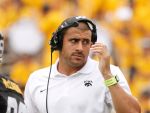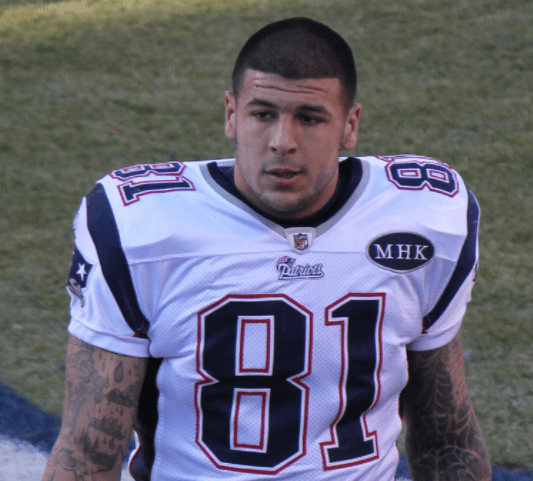When Aaron Hernandez was found dead in his prison cell back in April, it seemingly put a tragic end to the story of a talented young football player who had broken as bad as one can break. At the time, the former New England Patriots tight end was serving a life sentence with no possibility of parole, stemming from a murder conviction stemming from the death of his former friend Odin Lloyd in 2013. He was found dead by apparent suicide, having hanged himself with a bed sheet, according to Massachusetts prison officials. Most believed that was the end of the story, but a report by a leading CTE research center on Thursday has written a new, and potentially game-changing chapter to the tale.
The report, which was released by Boston University’s CTE Center on Thursday afternoon, asserts that Hernandez had stage 3 CTE (a brain disease caused by repeated head trauma), one of the most advanced cases of the disease ever seen. To put it in simpler terms, the 27-year-old Hernandez allegedly had the brain of a 67-year-old man due to the disease.
As a result of the findings in the report, Hernandez’s fiancée, Shayna Jenkins-Hernandez, has filed a suit on behalf of herself and the couple’s daughter, Avielle Hernandez, stating that the NFL and the Patriots are responsible for Hernandez’s death by suicide. The suit does not implicate the league or the club in the murder of Odin Lloyd, as CTE has not been found to provoke murder in people with the disease; however, there have been findings that directly tie it to suicidal thoughts and actions, which is what Jenkins-Hernandez and the couple’s attorney, Jose Baez, are challenging in court. The family is demanding $20 million in damages for loss of parental consortium, which would be paid to Avielle.
That Hernandez played his last game at the age of 23, and that he only played 44 NFL games before his arrest, has increased the worries around football and the safety of those who devote their lives to the sport. Concussions have shot to the forefront of the national discussion surrounding football in recent years, as more and more athletes have been found to be dealing with an unsafe number of head injuries. The Hernandez lawsuit isn’t the first time that the NFL has been under legal fire due to concussions, even in recent years. The family of Junior Seau–the former San Diego Chargers and Patriots linebacker who died by a self-inflicted gunshot to the chest in 2012–has been pursuing a case against the league since his death. Seau purposefully shot himself in the chest so that his brain could be studied, and he was found to have CTE in the brain autopsy.


The biggest case against the NFL, however, was the class action lawsuit and landmark settlement that was finalized earlier in 2017. The 65-year, $1 billion settlement is meant to protect retired players who were injured to the point of disability, or who died as a result of injuries that occured during their football days, including brain injuries (such as CTE). Despite a botched rollout and what is objectively still a low figure (there are over 20,000 players covered under the settlement, which was originally for $765 million, before a judge ruled in 2015 that that number was too low), it was the first notable defeat taken by the league in court. While it was generally agreed that the league dodged a bullet by settling for a comparatively low number, the settlement might have opened the door for new cases to get further in the process against the NFL.
The difference between that billion dollar lawsuit and the Aaron Hernandez case is simple: while a good number of players involved in the first suit were still alive, the tight end’s family is being represented after his death by Baez. That means that they might be less likely to take a settlement, as the players in the original case would want to take the money rather than drag the process out in court. That’s not to say that the Hernandez family won’t eventually take a settlement, but Baez appears ready for a long court battle. If Hernandez’s family were to win against the NFL–or even if they were to get a large enough settlement–it could open a torrent of posthumous litigation from the families of other football players who were diagnosed with CTE after their deaths. That’s not what the NFL should fear most, however.
In the fight against CTE, the NFL has never faced a tougher situation than the one it’s about to embark on with Hernandez’s family.
If the case goes to trial–not a certainty, as the NFL has certain safeguards against that in its collective bargaining agreement with the players’ union–certain key characters would likely be called upon to testify under oath. Specifically, NFL Commissioner Roger Goodell, and Patriots personnel like owner Robert Kraft and coach Bill Belichick, would be called onto the stand. It’s here that information that damages the NFL’s claims, that they are doing everything they can to prevent CTE, could come into question. It’s a well-known secret within football circles that players lie about concussions, hiding them so as to not be removed from games; could a trial for the Hernandez lawsuit also reveal that teams hid concussions? Or that the league knew about the CTE problem before it became a publicly known fact? It’s possible, and it’s certainly something that Baez will be trying to prove in order to find the league and the team culpable in Hernandez’s death. It could also set a precedent for future lawsuits that could begin to deplete the NFL’s considerable legal fund war chest. What happens then?

In the fight against CTE, the NFL has never faced a tougher situation than the one it’s about to embark on with Hernandez’s family. Due to the unique circumstances surrounding his death–Massachusetts vacated his murder conviction as he died while awaiting an appeal, and CTE has been linked with suicide in the past–it will not be a sure thing for the league to prove that it does not have some responsibility to Hernandez’s family.
While the league may eventually win if they go to trial, it may not want to go that far, as it has previously been secretive with regards to its data regarding the disease. The NFL may choose instead to bestow a large settlement onto the family, which could open the metaphorical floodgates for other lawsuits. Whether those are successful or not might not matter; if the NFL is constantly taken to court, it will make the $1 billion settlement feel like even more of a dodged bullet for America’s most popular sports league. Can the NFL survive that? Only time–and the courts–will tell.




